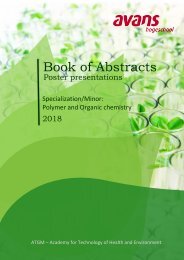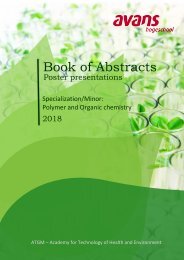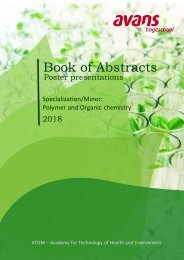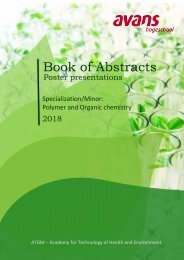Book of abstracts version 5
Create successful ePaper yourself
Turn your PDF publications into a flip-book with our unique Google optimized e-Paper software.
Synthesis <strong>of</strong> a ligand for a synthetic [NiFe] hydrogenase model<br />
Figure 1 : Overall reaction<br />
Author<br />
Egor Silin<br />
Academy <strong>of</strong> Technology for Health and Environment<br />
Avans Hogeschool, Breda<br />
University <strong>of</strong> Leiden<br />
ligand for a synthetic [NiFe] hydrogenase model<br />
Abstract<br />
Hydrogen gas is a good candidate to replace the fossil fuels as an energy carrier. The hydrogen economy relies on the<br />
vision to replace the fossil fuels, using hydrogen as a low-carbon energy source. A way <strong>of</strong> producing hydrogen gas is using<br />
a hydrogen evolution reaction with an electro catalyst. This is possible with an enzyme present in certain microorganisms<br />
and is called hydrogenase [1]. The goal <strong>of</strong> this study is to synthesize a ligand with all substituted carbons present in the<br />
benzene, which can be used for the synthesis <strong>of</strong> the hydrogenase model for the University <strong>of</strong> Leiden. The ligand must<br />
have a complex <strong>of</strong> four sulphur atoms, so it could donate electrons to the metal complex present in the hydrogenase<br />
model. This is shown in Figure 1. Currently the ligand is being synthesized using Hexakis(bromomethyl)benzene as starting<br />
material. First, the present bromides were replaced with thioureum groups and hydrolysed with a base, to create a<br />
thiolproduct. After the synthesis <strong>of</strong> the thiolproduct, the product has reacted with 1 -chloro-2-methyl-2-propanol,<br />
resulting a bridge where another sulphur atom can be attached. The next step was to replace the hydroxy group with a<br />
halogen, using the thionylchloride as reagent. This reaction gave a shift <strong>of</strong> the two present methyl -groups to the beta<br />
carbon[3]. At last, the product from the previous step has reacted with thioureum under nitrogen, resulting the final<br />
ligand product. This is shown in Figure 2. The monsters were analysed with FTIR and 1 H-NMR.<br />
Keywords: Hydrogenas e, metal-ligand, Sn 2 -reaction.<br />
Table <strong>of</strong> content<br />
Figure 1: Target molecule<br />
Figure 2: Reaction equation<br />
[1] Lubitz, W., Ogata, H., Rüdiger, O., & Reijerse, E. (2014). Hydrogenases. Chemical Reviews , 4081-4148.<br />
[2] ] Verhagen, J. A., Ellis, D. D., Lutz, M., Spek, A. L., & Bouwman, E. (2002). Synthesis, characterisation and crystal<br />
structures <strong>of</strong> new nickel complexes in S4 coordination spheres; an unprecedented rearrangement during ligand synthesis.<br />
The Royal Society <strong>of</strong> Chemistry , 1275-1280.<br />
61









